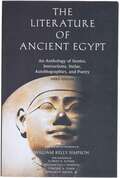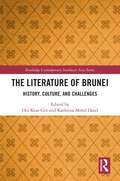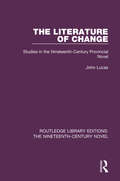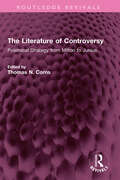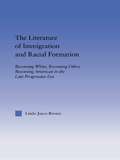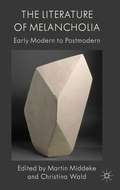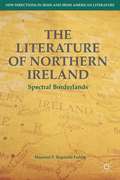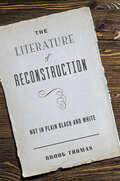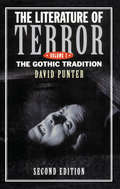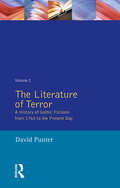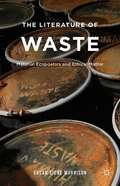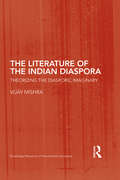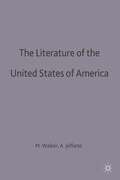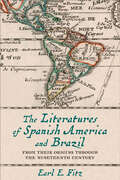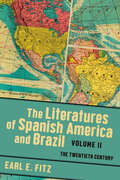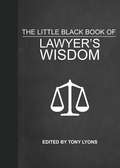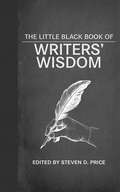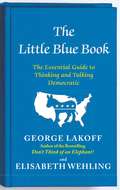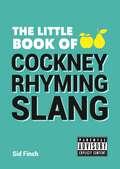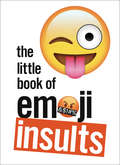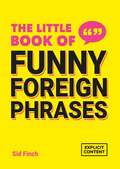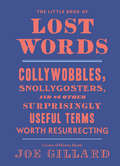- Table View
- List View
The Literature of Ancient Egypt: An Anthology of Stories, Instructions, Stelae, Autobiographies, and Poetry
by William Kelley Simpson Robert K. Ritner Vincent A. Tobin Jr. Edward WenteThe latest edition of this highly praised anthology of ancient Egyptian literature offers fresh translations of all the texts as well as some twenty-five new entries, including writings from the late literature of the Demotic period at the end of classical Egyptian history. Praise for the earlier editions: “An elegant, easily readable, and most serviceable volume.”—K. A. Kitchen, Journal of Near Eastern Studies “A reliable rendering of the Egyptian text that can be useful to students of Egyptology and provide the layman with delightful reading material.”—Mordechai Gilula, Cultura
The Literature of Brunei: History, Culture, and Challenges (Routledge Contemporary Southeast Asia Series)
by Kathrina Mohd Daud Ooi Keat GinThis book presents an overview of the literature of Brunei, surveying literary traditions, innovations, and new approaches as well as historical and contemporary issues and challenges.This book highlights the unique characteristics of Bruneian literature, including its approach to bilingualism - Brunei Malay and English - its historical intertwining with monarchs and myths, and how its emerging developments can be charted in the twenty-first century.Gathering together the work of both established and emerging scholars of Bruneian literature and history, this book brings detailed scholarship to an English-speaking audience, some of which was originally written in the Malay language, and highlights a Bruneian perspective. In drawing out the peculiar traditions, innovations, and challenges of Bruneian literature, this collection of essays is not only original in concept but also a pioneering endeavour.The Literature of Brunei will be of interest to researchers in World and Asian Literature, in particular Southeast Asian literature.
The Literature of Change: Studies in the Nineteenth Century Provincial Novel (Routledge Library Editions: The Nineteenth-Century Novel #24)
by John LucasFirst published in 1977, this book studies three important nineteenth-century novelists: Mrs Gaskell, William Hale White and Thomas Hardy. They are all provincial novelists who wrote about social change and the attendant problems and pressures this brought with it. Unlike previous critics, who have tended to concentrate on her ‘social-problem’ novels, here the author treats Gaskell’s Sylvia’s Lovers and Cousin Phillis as central texts. However a chapter also examines Gaskell and Engels perception of social change in Manchester. This book also seeks to correct Hale White’s neglect, anointing Revolution in Tanner’s Lane and Clara Hopgood major works. The survey of women in Hardy’s novels represents an illuminating new angle and leads on to a discussion of love and marriage in later Victorian fiction.
The Literature of China in the Twentieth Century
by Kam Louie Bonnie S. McdougallIn this general history of modern Chinese literature, McDougall (Chinese literature, Edinburgh U.) describes the fiction, drama, and poetry, and the historical and cultural developments, in three key periods: first, 1900-37, when Western influences led to new concepts of literature; second, 1938-65, when the Japanese invasion and the rise of the Communists marked a return to Chinese traditions followed by political restraint of literary production; and third, 1966-89, when underground literature set the stage for an era of experimentation. Annotation c. by Book News, Inc., Portland, Or.
The Literature of Controversy: Polemical Strategy from Milton to Junius (Routledge Revivals)
by Thomas N. CornsFirst published in 1987, The Literature of Controversy is a collection of essays by scholars from Britain, the United States, and Australia on major works from a classic epoch of English controversial prose. Each essay engages a single text or series of texts, less to discuss the ideas and arguments per se than to consider the rhetorical techniques assumed for the political manipulation of the readers. Though emphasis varies from contribution to contribution, the purpose, broadly, is to explore how the constituents of those texts are organised to coax, cajole, persuade or inspire those to whom they address. As the editor argues in his introduction, this approach, the critique of polemical strategy, for the most part accepts the validity of paying regard to the author and his intentions; it engages questions about the responses of the readership at which the texts were targeted; and it proceeds intertextuality in its attempts to reconstruct the controversies in which the texts were embedded and the codes within which they operated. This book will be of interest to students of literature, rhetoric and history.
The Literature of Immigration and Racial Formation: Becoming White, Becoming Other, Becoming American in the Late Progressive Era (Studies in American Popular History and Culture)
by Linda Joyce BrownThis work examines early twentieth-century literature about women immigrants in order to reveal the differing ways that American racial categories and identities, particularly that of whiteness, were textually and socially constructed at the beginning of the twentieth century.
The Literature of Melancholia
by Christina Wald Martin MiddekeThis collection analyzes philosophical, psycho-analytic and aesthetic contexts of the discourse of melancholia in British and postcolonial literature and culture and seeks to trace the multi-faceted phenomenon of melancholia from the early modern period to the present. Texts discussed range from Shakespeare and Milton to Coetzee and Barker.
The Literature of Northern Ireland
by Maureen E. Ruprecht FademThrough close readings of texts by playwright Anne Devlin, poet Medbh McGuckian, and novelist Anna Burns, this book examines the ways Irish cultural production has been disturbed by partition. Ruprecht Fadem argues that literary texts address this tension through spectral, bordered metaphors and juxtapositions of the ancient and the contemporary.
The Literature of Reconstruction: Not in Plain Black and White
by Brook ThomasReconstruction-era literature helped shape an ongoing national debate about proper remedies to racial wrongs.In this powerful book, Brook Thomas revisits the contested era of Reconstruction. He evokes literature’s immediacy to recreate arguments still unresolved today about state versus federal authority, the government’s role in education, the growing power of banks and corporations, the paternalism of social welfare, efforts to combat domestic terrorism, and the difficult question of who should rightly inherit the nation’s past. Literature, Thomas argues, enables us to re-experience how Reconstruction was—and remains—a moral, economic, and political debate about which world should have emerged after the Civil War to mark the birth of a new nation.Drawing on neglected nineteenth-century historiographies and recent scholarship that extends the dates of Reconstruction in time while stretching its geographic reach beyond the South, The Literature of Reconstruction uses literary works to trace the complicated interrelations among the era’s forces. Thomas also explores how these works bring into dialogue competing visions of possible worlds through chapters on reconciliation, federalism, the Ku Klux Klan, railroads, and inheritance. He contrasts well-known writers, including W. E. B. Du Bois, Thomas Dixon, and Charles W. Chesnutt, with relatively neglected ones, including Albion W. Tourgée, María Amparo Ruiz de Burton, and Constance Fenimore Woolson. Some authors opposed Reconstruction; others supported it; and still others struggled with mixed feelings. The world Thomas conjures up in this groundbreaking new study is one in which successful remedies to racial wrongs remain to be imagined.
The Literature of Terror: The Gothic Tradition
by David PunterThe first edition was regarded as the definitive survey of Gothic and related terror writing in English. No other text considers this genre on such a scale and covers the theoretical perspectives so comprehensively. In the latest edition, the broad range of theoretical perspectives has been enlarged to include modern critical theories. Volume One is a thoroughly updated edition of the original text, covering the period from 1765 up to the Edwardian age, exploring the richness and literary diversity of the gothic form: from the original eighteenth-century gothic of Ann Radcliffe to the melodramatic fiction of Wilkie Collins.
The Literature of Terror: The Modern Gothic
by David PunterThe Literature of Terror: the Modern Gothic is the second volume in David Punter's impressive survey of gothic writing covering over two centuries. This long awaited second edition has been expanded to take into account the latest critical research, and is now published in two volumes. Volume One covers the period from 1765 to the Edwardian age while Volume Two discusses modern gothic, starting with the 'decadent' gothic writing of Oscar Wilde and continuing through the twentieth century.
The Literature of Waste
by Susan Signe MorrisonTracing material and metaphoric waste through the Western canon, ranging from Beowulf to Samuel Beckett, Susan Morrison disrupts traditional perceptions of waste to better understand how we theorize, manage, and are implicated in what is discarded and seen as garbage. Engaging a wide range of disciplines, Morrison addresses how the materiality of waste has been sedimented into a variety of toxic metaphors. The vibrancy of matter itself disturbs these metaphors, especially those used to characterize people as disposable garbage. If scholars can read waste as possessing dynamic agency, how might that change the ethics of refuse-ing and ostracizing wasted humans? A major contribution to the growing field of Waste Studies, this comparative and theoretically innovative book confronts the reader with the ethical urgency present in waste literature itself.
The Literature of the Indian Diaspora: Theorizing the Diasporic Imaginary (Routledge Research in Postcolonial Literatures)
by Vijay MishraThe Literature of the Indian Diaspora constitutes a major study of the literature and other cultural texts of the Indian diaspora. It is also an important contribution to diaspora theory in general. Examining both the ‘old’ Indian diaspora of early capitalism, following the abolition of slavery, and the ‘new’ diaspora linked to movements of late capital, Mishra argues that a full understanding of the Indian diaspora can only be achieved if attention is paid to the particular locations of both the ‘old’ and the ‘new’ in nation states. Applying a theoretical framework based on trauma, mourning/impossible mourning, spectres, identity, travel, translation, and recognition, Mishra uses the term ‘imaginary’ to refer to any ethnic enclave in a nation-state that defines itself, consciously or unconsciously, as a group in displacement. He examines the works of key writers, many now based across the globe in Canada, Australia, America and the UK, – V.S. Naipaul, Salman Rushdie, M.G. Vassanji, Shani Mootoo, Bharati Mukherjee, David Dabydeen, Rohinton Mistry and Hanif Kureishi, among them – to show how they exemplify both the diasporic imaginary and the respective traumas of the ‘old’ and ‘new’ Indian diasporas.
The Literature of the United States of America
by Marshall WalkerThis new edition updates the study of American literature with the inclusion of poets from Hart Crane and E. E. Cummings to John Ashbery and A. R. Ammons and novelists from William Burroughs to John Irving. More space is given to drama and Black, Jewish and women writers to demonstrate that American literary history can no longer be considered largely in terms of regional dominances. Marshall Walker is author of Robert Penn Warren: A Vision Earned(1979).
The Literatures of Spanish America and Brazil: From Their Origins through the Nineteenth Century (New World Studies)
by Earl E. FitzIn this survey of Central and South American literature, Earl E. Fitz provides the first book in English to analyze the Portuguese- and Spanish-language American canons in conjunction, uncovering valuable insights about both. Fitz works by comparisons and contrasts: the political and cultural situation at the end of the fifteenth century in Spain and Portugal; the indigenous American cultures encountered by the Spanish and Portuguese and their legacy of influence; the documented discoveries of Colón and Caminha; the colonial poetry of Mexico’s Sor Juana Inés de la Cruz and Brazil’s Gregório de Matos; culminating in a meticulous evaluation of the poetry of Nicaragua’s Rubén Darío and the prose fiction of Brazil’s Machado de Assis. Fitz, an award-winning scholar of comparative literature, contends that at the end of the nineteenth century, Latin America produced two great literary revolutions, both unique in the western hemisphere, and best understood together.
The Literatures of Spanish America and Brazil: The Twentieth Century (New World Studies)
by Earl E. FitzCharting the twentieth-century course of the literature of the Americas The second volume of Earl E. Fitz&’s magisterial survey of the field, The Literatures of Spanish America and Brazil: The Twentieth Century analyzes Spanish- and Portuguese-language writing throughout South and Central America as well as in the United States and Canada, where it expanded and flourished over the course of the century. Fitz argues that Spanish American and Brazilian literatures should be treated as two sides of the same coin, together forging a hemispheric identity as new literary aesthetics and political crises swept through the Americas. Fitz takes readers on a comparative journey, analyzing writers such as Octavio Paz and Juan Rulfo from Mexico, Julia de Burgos and Luis Palés Matos from Puerto Rico, Jorge Luis Borges and Victoria Ocampo from Argentina, and Mário de Andrade and Patrícia Galvão from Brazil, among many others, to inspire a more thoroughly integrated understanding of the literature of the Americas.
The Little Black Book of Lawyer's Wisdom
by Tony LyonsA handy guide to legal wisdom past and present.To be a lawyer or a politician or a judge, one must dedicate their lives to serving the public good. For anyone considering a career in law or anyone interested in philosophy, politics, and/or government, herein you will find an entertaining and educational collection of legal wisdom from some of history’s greatest thinkers. The road to justice is not always easy. It is fraught with conflict, scandal, adversity, and sleepless nights. It is a noble and necessary pursuit as society continues to progress and seek equality for all. Words from renowned lawyers, judges, authors, politicians, philosophers, and preachers make up this diverse assortment of over two hundred memorable, bite-sized quotations about justice, philosophy, crime, the life of a lawyer, landmark cases, and more!Included are such quotations as:"Let all laws by clear, uniform, and precise; to interpret laws is almost always to corrupt them.” -Voltaire"If in your own judgment you cannot be an honest lawyer, resolve to be honest without being a lawyer.” -President Abraham Lincoln"The first duty of society is justice.” -Alexander Hamilton"A system of justice is the richer for diversity of background and experience.” -U.S. Supreme Court Justice Ruth Bader Ginsburg
The Little Black Book of Writers' Wisdom
by Steven D. PriceAuthor and journalist Gene Fowler put it best: "Writing is easy; all you do is sit staring at a blank sheet of paper until the drops of blood form on your forehead." Anyone who has ever wanted or been required to create something more complicated than a shopping list or a Tweet knows there's more truth than poetry in the observation. The process can be difficult, frustratingly so when we realize that although we use words all the time, coming up with the right ones can be a daunting task.Even the most celebrated writers have reflected on this creative process, and their observations and conclusions are collected in this book. The compiler, himself no stranger to a blank page or computer screen, has selected the wisest and wittiest utterances on such subjects as why we write (Ernest Hemingway: "I have a good life but I must write because if I do not write a certain amount I do not enjoy the rest of my life."); how to write (Anton Chekhov: "Don't tell me the moon is shining; show me the glint of light on broken glass."); and writing for money (Cormac McCarthy: "I never had any doubts about my abilities. I knew I could write. I just had to figure out how to eat while doing this.").It has been said that reading won't make you a good writer, but it will make you a better writer. Dip into this lively and useful treasure trove, and you'll be well on your way.
The Little Blue Book
by George Lakoff Elisabeth WehlingThe indispensable handbook for Democrats Voters cast their ballots for what they believe is right, for the things that make moral sense. Yet Democrats have too often failed to use language linking their moral values with their policies. The Little Blue Book demonstrates how to make that connection clearly and forcefully, with hands-on advice for discussing the most pressing issues of our time: the economy, health care, women's issues, energy and environmental policy, education, food policy, and more. Dissecting the ways that extreme conservative positions have permeated political discourse, Lakoff and Wehling show how to fight back on moral grounds and in concrete terms. Revelatory, passionate, and deeply practical, The Little Blue Book will forever alter the way Democrats and progressives think and talk about politics.
The Little Book of Cockney Rhyming Slang
by Sid FinchWhether you want to impress your friends with your London lingo, or simply to understand what the characters on EastEnders are talking about, The Little Book of Cockney Rhyming Slang is packed with everything you need. It'll be perfect when you're on the dog and bone to your best china plates, or down the rub-a-dub with your trouble and strife.
The Little Book of Cockney Rhyming Slang
by Sid FinchWhether you want to impress your friends with your London lingo, or simply to understand what the characters on EastEnders are talking about, The Little Book of Cockney Rhyming Slang is packed with everything you need. It'll be perfect when you're on the dog and bone to your best china plates, or down the rub-a-dub with your trouble and strife.
The Little Book of Emoji Insults
If you can't say something nice... say it in emoji.Shock your friends and family with this brilliantly offensive collection of emoji put-downs and comebacks.With this handy guide, the endless potential for a punishing emoji burn will be opened to you like never before – far beyond just relying on the classic middle finger symbol. From everyday insults to brutal Shakespearean zingers, classic movie put-downs to the best ‘your mum’ jokes, this is your complete phrasebook for the ever more savage world of emoji insults.
The Little Book of Funny Foreign Phrases: A Collection of Creative, Hilarious and Ridiculous Sayings from Across the Globe
by Summersdale PublishersEver been stuck for a phrase that sums up exactly how you feel? These hilarious foreign expressions have got you covered in every scenario. With a variety of sayings from around the world, this entertaining compilation will equip you to insult your friends, proclaim your feelings and speak your mind in new and creative ways.
The Little Book of Funny Foreign Phrases: A Collection of Creative, Hilarious and Ridiculous Sayings from Across the Globe
by Summersdale PublishersEver been stuck for a phrase that sums up exactly how you feel? These hilarious foreign expressions have got you covered in every scenario. With a variety of sayings from around the world, this entertaining compilation will equip you to insult your friends, proclaim your feelings and speak your mind in new and creative ways.
The Little Book of Lost Words: Collywobbles, Snollygosters, and 86 Other Surprisingly Useful Terms Worth Resurrecting
by Joe GillardThe founder of History Hustle presents a handy guide for expressing yourself with history's best words. This collection features scores of unique words from history that deal with surprisingly modern issues like sleeping in and procrastination--proving that some things never change! The Little Book of Lost Words presents each term that's ready to be brought back into modern-day use, complete with definition, hilarious sample sentence, and cheeky historical art. You'll learn new words for the cozy room where you like to Netflix and chill (snuggery), for a dishonest politician (snollygoster), and for a young person who sleeps through the day and doesn't work (dewdropper). If you like Lost in Translation, Shakespeare Insult Generator, Drunk History, and Roald Dahl--and you delight in the way words like blatteroon and flapdoodle roll off the tongue--then you're the word lover this book was written for. Want to know what a fizgig or groke is? Read this book!
